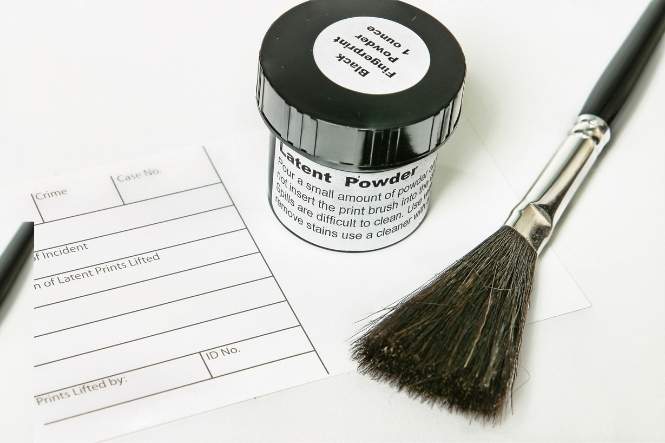Latent Prints are one of three categories of fingerprints that can be found at the scene of a crime.
About Fingerprints
Fingerprints are split into three categories:
- Latent
- Impressed
- Patent
Patent prints are those fingerprints that are easily spotted without the use of magnesium powders, ultra violet lights or chemicals that might assist in the visualisation of such a print. Patent prints are often found perhaps in blood, ink, oil or on surfaces such as glass, wooden doorframes or paper.
Impressed prints are those that have been made in soft material or tissue by pressing down with the finger or hand. These prints can be photographed or in certain circumstances moulds made if they are very fragile.
Latent prints – the particular fingerprint we are interested in here – are prints that are not visible to the naked eye but do exist.
Latent Prints
These prints are created because the fingers have tiny outlets for the expulsion of sweat and these outlets pick up salts, oils and tiny particles of dirt along the way. You may think that your hands and fingers are clean but at any given time your fingers are picking up these tiny molecules in everyday life; a common means of picking up these tiny particles is the passing of paper from one individual to another. Paper – and paper of many different types – although looking clean can carry a thin film of dirt and sweat particles that are passed on.
These particles – amplified if you run your fingers through your hair or rub your face – can then be passed to hard surfaces.
Latent prints are visualised using magnesium powder, which is gently brushed over these hard and shiny surfaces in order to illuminate them. Once this is done the prints can be photographed or ‘lifted’ using a variety of different tapes. A Scenes of Crime Officer (SOCO) will have an extensive selection of powders and brushes in their kit, which has now become widely known as the CSI kit – CSI standing for Crime Scene Investigation. These varying brushes are used to provide different coverings of powders when ‘dusting’ for prints so that the print is covered sufficiently for display without distorting its appearance.
Likewise some chemicals can be used in order to show up these otherwise invisible prints. One such chemical is Cyanoacrylate, which can be found in ordinary everyday super glue and can be used as a means of showing up the latent print by releasing a vapour that reacts to the salt and oil in the fingerprint. Other chemicals such as Iodine and Silver Nitrate are also used in the display of latent prints.
It is imperative that once these latent prints are exposed that they are photographed or ‘lifted’ without delay as some prints can fade quickly. Likewise it is imperative that when ‘dusting’ the crime scene for prints that only those individuals who are directly involved in the collating of information are present and that they are correctly adorned in protective clothing so as to reduce the risk of contamination to print and other trace evidence to be found there.

